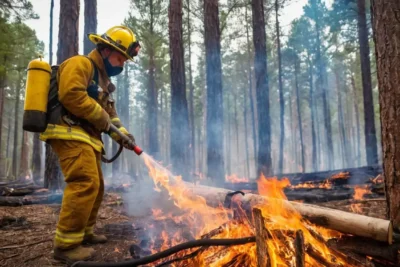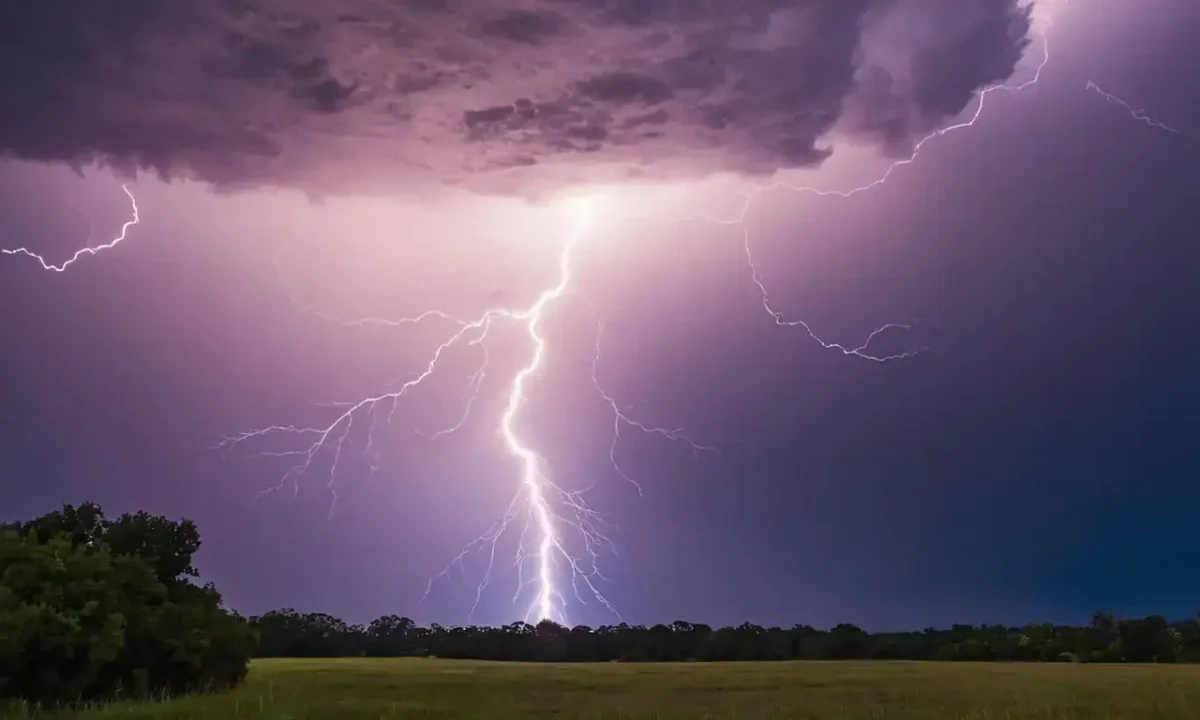
Lightning: Formation, Charge Separation and Discharge

Lightning is one of nature's most awe-inspiring phenomena, a dramatic display of electrical energy that illuminates the night sky. This powerful discharge occurs within thunderstorms, where charged particles collide, creating an imbalance in electric potential. Understanding how lightning forms, its role in atmospheric processes, and the safety precautions associated with it can enhance our appreciation for this natural spectacle while ensuring personal well-being during stormy weather.
This article delves into the fascinating world of electricity storm (also known as electric storms), exploring the intricate mechanisms behind lightning formation. We will examine the role of ice crystals, droplets, and electric fields in charge separation, followed by a discussion on how these charges create conductive paths for discharge. Additionally, we'll explore different types of lightning and their characteristics, highlighting the physics involved in each event. Finally, we'll touch upon safety measures during thunderstorms to minimize risks associated with this powerful natural phenomenon.
Charge Separation and Cloud Formation
The formation of lightning is intricately linked to the processes occurring within thunderclouds. These clouds are not just masses of water droplets; they contain a complex interplay of charged particles that contribute to the electrical instability necessary for lightning discharge. The process begins with the collision of ice crystals, which are typically larger than raindrops, and supercooled water droplets within the cloud.
As these particles collide, they transfer energy through friction, leading to the separation of electric charges. Typically, the top portion of the cloud becomes positively charged due to the accumulation of excess electrons from collisions between ice crystals and droplets. Conversely, the bottom of the cloud develops a negative charge as it attracts the negatively charged ground below. This separation creates an electric field that extends throughout the entire cloud.
The magnitude of this electric field is crucial in determining the likelihood of lightning formation. When the electric potential difference between the cloud's top and bottom becomes sufficiently large, it overcomes the insulating properties of air molecules. This allows a conductive path to form, enabling the discharge of electrical energy as lightning.
Role of Ice Crystals and Droplets
Ice crystals play a vital role in electricity storm formation by contributing significantly to charge separation within thunderclouds. These ice crystals are typically found at high altitudes within the cloud, where temperatures are below freezing. As these crystals collide with smaller water droplets, they transfer energy through friction, leading to the creation of static electricity.
The collision between ice crystals and water droplets is a key factor in electricity storm formation. When these particles collide, they generate an electric field that can accumulate charge within the cloud. This process is further enhanced by the presence of updrafts and downdrafts within the cloud, which help to distribute charges throughout the entire structure.
The size and shape of ice crystals also influence their ability to contribute to electricity storm formation. Larger ice crystals tend to be more efficient at transferring energy through collisions, leading to a greater separation of charges. This is because larger particles have a higher surface area for interaction, allowing them to transfer energy more effectively than smaller particles.
Electric Field Development
The electric field within thunderclouds plays a crucial role in electricity storm formation. As the negatively charged cloud bottom attracts the positively charged ground below, an electric field develops that extends throughout the entire cloud. This field is responsible for creating the conductive path necessary for lightning discharge.
The strength of this electric field is influenced by several factors, including the presence of water droplets and ice crystals within the cloud. The collision between these particles generates static electricity, which contributes to the overall charge separation. Additionally, updrafts and downdrafts within the cloud can further amplify the electric field, making it more conducive to lightning formation.
Understanding the role of the electric field is essential for predicting lightning strikes. Meteorologists use sophisticated models that incorporate factors like atmospheric pressure, temperature, and humidity to predict areas where thunderstorms are likely to develop. This information helps them issue timely warnings about potential hazards, allowing people to take necessary precautions during storms.
Path Formation for Discharge

Once a conductive path has been formed within the cloud, the next step is the actual discharge of electrical energy as lightning. This process involves the movement of electrons from the negatively charged bottom of the cloud towards the positively charged ground below.
The formation of this conductive path is facilitated by several factors. First, the presence of ice crystals and water droplets creates a medium for charge separation. As these particles collide, they transfer energy through friction, leading to the accumulation of charges within the cloud. Second, updrafts and downdrafts within the cloud help to distribute these charges throughout the entire structure.
Finally, the electric field generated by the charged particles creates an imbalance in potential that overcomes the insulating properties of air molecules. This allows a conductive path to form, enabling the discharge of electrical energy as lightning. The lightning bolt we observe is essentially a massive release of stored electrical energy, which travels through the atmosphere at incredible speeds.
Types of Lightning and Their Characteristics
Lightning comes in various forms, each with unique characteristics that reflect the complex processes occurring within thunderclouds. Understanding these different types can enhance our appreciation for this natural phenomenon while providing valuable insights into its behavior.
One common type is intracloud lightning, which occurs within the same cloud where it originates. These strikes are typically associated with strong updrafts and downdrafts, leading to a rapid change in electrical potential within the cloud. Another type is intercloud lightning, which occurs between different clouds. This type of lightning often involves a more gradual build-up of charges, resulting in longer duration flashes.
Cloud-to-ground lightning is another common type that occurs when a discharge travels from the cloud to the ground below. These strikes are typically associated with strong updrafts and downdrafts, leading to a rapid transfer of electrical energy. Finally, positive lightning, which is less frequent but still significant, involves a discharge traveling from the positively charged top of the cloud towards the negatively charged bottom.
Understanding these different types of lightning can help us better predict their occurrence and potential hazards associated with them. This knowledge allows for more effective safety measures during thunderstorms, ensuring the well-being of individuals in potentially hazardous situations.
The Physics of Lightning Strikes
Lightning strikes are a fascinating example of how electrical energy interacts with atmospheric conditions. These discharges occur when a conductive path is formed within thunderclouds, allowing a massive release of stored electrical energy.
The physics behind lightning strikes involves several key factors. First, the electric field generated by charges within the cloud creates an imbalance in potential that overcomes the insulating properties of air molecules. This allows for the formation of a conductive path, enabling the discharge of electrical energy as lightning.
Second, the speed at which lightning travels is incredibly fast, reaching speeds of up to 70 miles per hour (112 kilometers per hour). This rapid movement contributes to the dramatic appearance of lightning strikes, often accompanied by loud booms and flashes. Finally, the interaction between lightning and air molecules creates a variety of effects, including ionization and the formation of plasma.
Understanding these physical processes can help us better appreciate the power and beauty of electricity storm phenomena while also promoting safety precautions during thunderstorms.
Safety Precautions During Thunderstorms
Thunderstorms pose potential hazards due to their association with lightning strikes. It is crucial to take necessary precautions during these weather events to minimize risks associated with this powerful natural phenomenon.
One of the most important steps is to seek shelter indoors whenever thunder roars. This includes staying away from windows, as flying debris can be dangerous. Additionally, avoiding open fields and tall trees can help reduce exposure to potential hazards. If caught outdoors without shelter, crouch low to the ground and avoid standing under a tree.
Another crucial safety measure is to stay away from water sources during thunderstorms. Water conducts electricity effectively, making it a significant hazard during these events. Finally, being aware of weather forecasts and following local advisories can help individuals make informed decisions about their safety during storms.
Environmental Impact of Lightning
Lightning plays a significant role in the environment, impacting various ecosystems and contributing to atmospheric processes. While often viewed as a destructive force, lightning also has beneficial effects on the planet.
One notable impact is its contribution to nitrogen fixation. Lightning strikes can initiate chemical reactions that convert nitrogen gas into usable forms for plants. This process is crucial for maintaining healthy ecosystems and supporting life on Earth. Additionally, lightning plays a role in cloud formation by creating ice crystals that contribute to cloud development.
Finally, lightning contributes to the production of ozone, which helps protect us from harmful ultraviolet radiation. While these effects are often overlooked, they highlight the complex interplay between natural phenomena and their impact on our planet.
Conclusion
Lightning is a fascinating phenomenon that showcases the power of nature's forces. From its role in atmospheric processes to its potential hazards during thunderstorms, understanding this natural event can enhance our appreciation for the environment while promoting safety precautions. By learning about lightning and taking necessary precautions, we can better navigate these weather events and ensure the well-being of ourselves and others.
Leave a Reply





Related Links